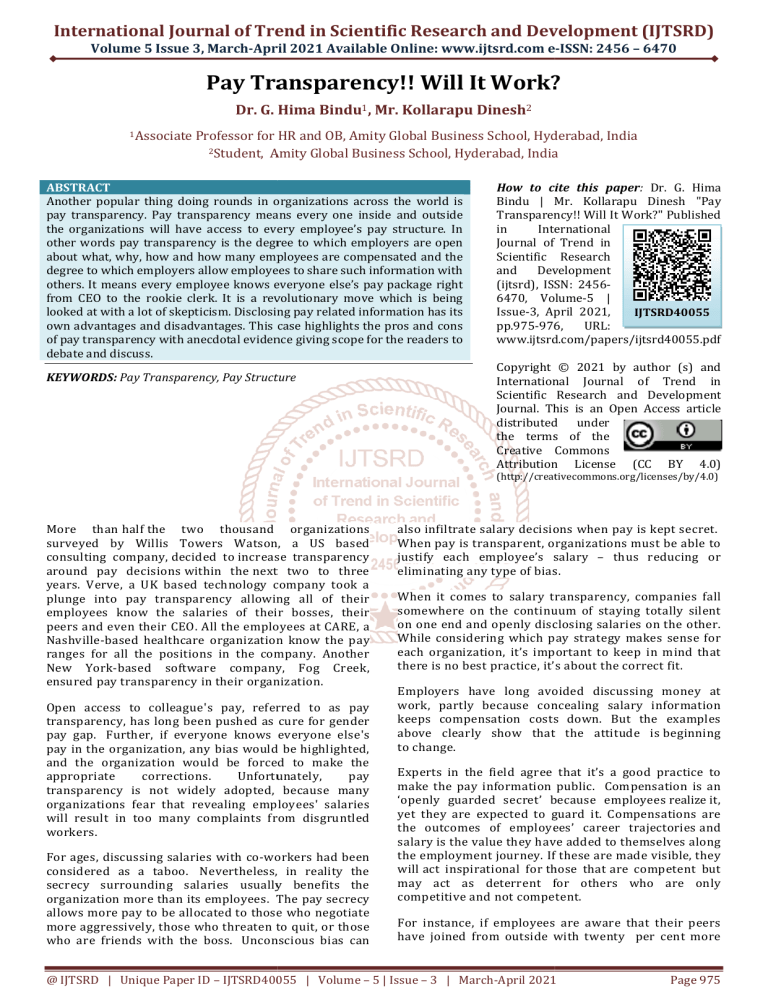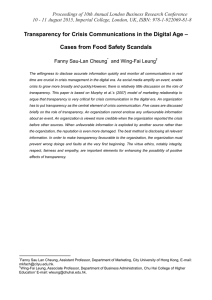
International Journal of Trend in Scientific Research and Development (IJTSRD) Volume 5 Issue 3, March-April April 2021 Available Online: www.ijtsrd.com e-ISSN: e 2456 – 6470 Pay Transparency!! Will It Work Work?? Dr. G. Hima Bindu1, Mr. Kollarapu Dinesh2 1Associate Professor for HR and OB OB, Amity Global Business School, Hyderabad, Hyderabad India 2Student, Amity Global Business School, Hyderabad Hyderabad,, India ABSTRACT Another popular thing doing rounds in organizations acr across the world is pay transparency. Pay transparency means every one inside and outside the organizations will have access to every employee’s pay structure. In other words pay transparency is the degree to which employers are open about what, why, how and how many employees are compensated and the degree to which employers allow employees to share such information with others. It means every employee knows everyone else’s pay package right from CEO to the rookie clerk. It is a revolutionary move which is be being looked at with a lot of skepticism. Disclosing pay related information has its own advantages and disadvantages. This case highlights the pros and cons of pay transparency with anecdotal evidence giving scope for the readers to debate and discuss. KEYWORDS: Pay Transparency, ransparency, Pay Structure How to cite this paper: paper Dr. G. Hima Bindu | Mr. Kollarapu Dinesh "Pay Transparency!! Will It Work?" Work Published in International Journal of Trend in Scientific Research and Development (ijtsrd), ISSN: 24562456 6470, Volume-5 Volume | Issue-3, 3, April 2021, IJTSRD40055 pp.975-976 6, URL: www.ijtsrd.com/papers/ijtsrd400 www.ijtsrd.com/papers/ijtsrd40055.pdf Copyright © 2021 20 by author (s) and International Journal of Trend in Scientific Research and Development Journal. This is an Open Access article distributed under the terms of the Creative Commons Attribution License (CC BY 4.0) (http://creativecommons //creativecommons.org/licenses/by/4.0) More than half the two thousand organizations surveyed by Willis Towers Watson, a US based consulting company, decided to increase transparency around pay decisions within the next two to three years. Verve, a UK based technology company took a plunge into pay transparency allowing all of their employees know the salaries of their bosses, their peers and even their CEO. All the employees at CARE, a Nashville-based healthcare organization know the pay ranges forr all the positions in the company. Another New York-based based software company, Fog Creek, ensured pay transparency in their organization. Open access to colleague's pay, referred to as pay transparency, has long been pushed as cure for gender pay gap. Further,, if everyone knows everyone else's pay in the organization, any bias would be highlighted, and the organization would be forced to make the appropriate corrections. Unfortunately, pay transparency is not widely adopted, because many organizations fear ear that revealing employees' salaries will result in too many complaints from disgruntled workers. For ages, discussing salaries with co-workers workers had been considered as a taboo. Nevertheless,, in reality the secrecy surrounding salaries usually benefits the organization more than its employees. The pay secrecy allows more pay to be allocated to those who negotiate more aggressively, those who threaten to quit, or those who are friends with the boss. Unconscious bias can also infiltrate salary decisions when wh pay is kept secret. When pay is transparent, organizations must be able to justify each employee’s salary – thus reducing or eliminating any type of bias. When it comes to salary transparency, companies fall somewhere on the continuum of staying totally totall silent on one end and openly disclosing salaries on the other. While considering which pay strategy makes sense for each organization, it’s important to keep in mind that there is no best practice, it’s about the correct fit. Employers have long avoided discussing money at work, partly because concealing salary information keeps compensation costs down. But the examples above clearly show that the attitude is beginning to change. Experts in the field agree that it’s a good practice to make the pay information public. Compensation is an ‘openly guarded secret’ because employees realize it, yet they are expected to guard it. Compensations are the outcomes of employees’ career trajectories and salary is the value they have added to themselves along alon the employment journey. If these are made visible, they will act inspirational for those that are competent but may act as deterrent for others who are only competitive and not competent. competent For instance, if employees are aware that their peers have joined from outside with twenty per cent more @ IJTSRD | Unique Paper ID – IJTSRD400 40055 | Volume – 5 | Issue – 3 | March-April 2021 1 Page 975 International Journal of Trend in Scientific Research and Development (IJTSRD) @ www.ijtsrd.com eISSN: 2456-6470 salary, they may crib, but the very fact remains that those employees had learnt along the journey, moved across companies, worked through difficult environments, and therefore, bring more perspective and knowledge to the work they are doing. The fairness of the whole process becomes evident. However, it's tough to make it transparent unless the core compensation practices, supported equality and impartiality are fed within the system. Disclosing pay related information has its intended benefits but it can have unfavorable effects as well. With the pay structures disclosed, employees might start comparing the pay differences which may lead many to question why other employees are earning more than themselves. For example, a home grown expert will come at a lower cost to the company than a worker bought in from the market. In many cases, the salary can be inversely proportional to the seniority of an individual. Pay transparency may incur additional costs for organizations. If employees find out what their peers are earning, especially if their colleagues are earning a higher wage than themselves, they might use such information to ask for a raise. This happened in 2015 when Erica Baker, an employee at Google made a spreadsheet containing details of employees’ salaries and shared it on the company’s internal network. Soon after that, many employees went ahead and asked for a pay rise at Google. On the other hand, pay transparency can be effective in getting away with gendered inequity in compensation. According to an Oxfam report published in 2019, the gender pay gap in India is 34 per cent, meaning that women in the same position with the same qualifications earn only two-thirds of their male peers. A transparent system will be an encouragement for women to demand equal pay. Creating a good ecosystem isn't easy, but not impossible. Questions: Can salaries be made transparent across organizations? Can India be transparent when it involves disclosure of salaries? REFERENCES [1] Casey Huch & Stacey Rapacki , Lessons on the Path to Pay Transparency, Willis Towers Watson, March 2019. https://www.willistowerswatson.com/enIN/Insights/2019/03/lessons-on-the-path-topay-transparency [2] Kim Elsesser, Pay Transparency is the solution to the pay Gap, Forbes Report, Sep. 2018. https://www.forbes.com/sites/kimelsesser/2018 /09/05/pay-transparency-is-the-solution-to-thepay-gap-heres-one-companys-successstory/?sh=16a94faa5010 [3] Prajjal Saha, Can Salaries be made Transparent across organizations?, HR Katha, Sep.2018 https://www.hrkatha.com/features/paytransparency-are-we-matureenough/#:~:text=An%20example%20of%20parti al%20pay,a%20specific%20number%20for%20e ach. [4] Kate Russel, How Pay Transparency Benefits Businesses, Businesses, World At Work, March. 2020. https://www.worldatwork.org/workspan/article s/how-pay-transparency-benefits-businesses [5] Madeline Buxton , A Google employee spreadsheet shows pay disparities between Men and Women, The New York Times, sep. 2017. https://www.refinery29.com/enus/2017/09/171485/google-employee-salaryspreadsheet @ IJTSRD | Unique Paper ID – IJTSRD40055 | Volume – 5 | Issue – 3 | March-April 2021 Page 976





